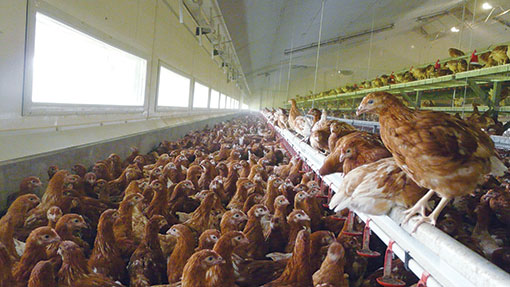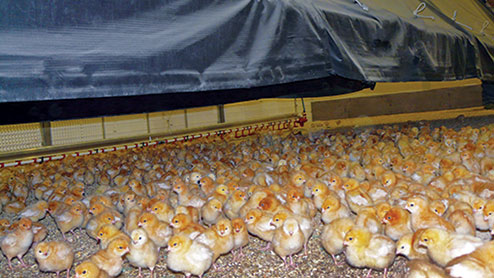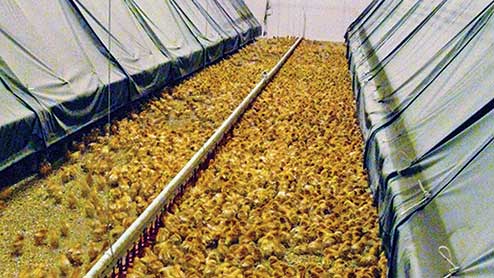Dark brooding pullet rearing system helps free-range hens

A new commercial pullet rearing system has been introduced by Performance Pullets, sister company to The Lakes Free Range Egg Co, which, it says, is producing better feathered, more active birds in less time than a conventional system.
Sitting on a 15-acre site alongside three existing pullet rearing units, the new 69m x 20m shed has a 20,000-chick capacity. It combines a dark brooding system with underfloor heating, energy efficiencies, natural light and monitoring equipment.
“Rearing our own chicks means we have better control and are able to influence the development of our free-range hens from day one,” says company owner David Brass. He aims to produce more active pullets that are less likely to feather peck, are better feathered, with improved bone strength and more mobility.
Commercial scale
There are already one or two small-scale units using dark brooding in UK, but Performance Pullets has scaled up the process to create a commercially viable system that mirrors the natural development of the chick brooding under the hen.
See more: Image is critical for Lakes free-range eggs
While most modern systems control chick behaviour by adjusting the house temperature, this system puts the chick in control. The brooders run the length of the shed and the heat stays constant, meaning the chick meets its own needs for heat.
Once the brooders are surplus to the chicks’ requirement – after about three weeks – and the birds are exploring the perches, feeders and multitier areas, the canopies are removed completely.
The set-up includes a bespoke electronic system from Israel-based Agro Logic, which enables accurate measurement and control of ammonia, CO2, temperature and feed usage.
It also incorporates continuous and consistent weighing of birds – with “hop up” plates weighing around 1,000 birds each day. This provides constant data from which performance can be analysed.
Lessons learned
“Challenges faced with this new technology included the fact there is no reference data on CO2 and ammonia levels for chick/pullet rearing,” says Mr Brass. “We are learning more every day, but we anticipate it will take several years to reach the pinnacle of optimisation.”
The first batch of pullets has been reared and is now laying on farms that supply the Lakes Free Range Egg Co. The second intake is benefiting from lessons learned with the first, including the optimum temperature, the height of the brooders and ventilation rates.

Early results indicate low seven day mortality at 0.5% and the birds are feathering two-to-three weeks ahead of those in traditional sheds. They are travelling off farm 100g heavier having utilised 500g a bird less feed than standard units.
The rearing facilities are located within a short distance from the free-range producers they supply, which in turn, keeps travel stress levels to a minimum. “Whatever we can do to reduce stress goes a long way to improving performance,” says Mr Brass.
The new facilities are lit by just seven LEDs, compared to the standard units with dozens of fluorescent lights.
Pullets also benefit from natural daylight, supplied from windows which are opened when the chicks reach five weeks of age.
“We are unaware of anyone else who does this, but to us it’s common sense to introduce as much of their future housing features as soon as possible – reduction in stress at this early stage is paramount,” says Mr Brass. “Our pullets are better suited to free range because they are more used to daylight when they arrive on farm.”
Energy savings
The whole rearing process uses 90% less energy than standard units. The underfloor heating is fed by a biomass boiler that has capacity to provide energy to all of the rearing units and facilities on site.

The £470,000 build cost includes £90,000 for the biomass boiler and incorporates elements of research and development. “We are working with Prof Christine Nicol and Dr Claire Weeks at Bristol University, who have helped us with the design and research. This is a world-leading facility, designed and developed with purpose. We’ve looked at the best things to do for better pullet performance, not necessarily the most cost-effective things, and are excited about the results so far.”
